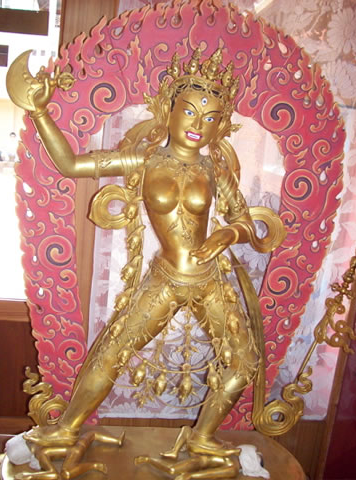Karmapa: Women are Equal on Buddhist Path toward Enlightenment.
All Buddhas are Created Equal.
You’d think, in Buddhism, that one’s capacity for enlightenment wouldn’t be circumscribed by gender. And, overall, through history, there’s been many wonderful examples of strong female buddhas.
Still, even today, women who seek ordination as a nun are often treated as second-class Buddhas. Pema Chodron herself had to travel to the one place on earth that would grant her a full ordination.
Excerpt:
…The ending of this relationship—which produced unexpectedly intense feelings of anger, fear, and groundlessness—sent Pema on a search for answers. She explored different therapies and spiritual traditions, but nothing seemed to address what she was feeling. Then she came upon an article by Chögyam Trungpa, “Working with Negativity.” Pema had had no exposure to Buddhism and didn’t even know the article was written by a Buddhist. But it had to do with using the emotions she was experiencing and understanding their wisdom. She decided to explore further what Trungpa had to say, and in 1974, having found some answers to her questions through his teachings, she was ordained as a novice nun. Over the ensuing years, Pema formally became a student of Trungpa’s and began practicing with great determination.
In 1981 Pema’s Tibetan teachers encouraged her to take the full nun’s ordination—to become a bhikshuni. But full ordination for women had been lost in the Tibetan tradition. Pema was therefore instructed to go to Hong Kong, to seek ordination from Chinese Buddhists who still performed this rite. Because she didn’t know where to go or whom to contact, it took a certain amount of both detective work and perseverance finally to locate a temple where she could be ordained. Pema was the only English-speaking person and the only Westerner who took ordination on that occasion.
In 1985, at the request of Chögyam Trungpa, Pema helped establish Gampo Abbey, the first Tibetan Buddhist monastery in North America for Western men and women. She also assumed the directorship of the abbey and its three-year retreat center…for the rest of her story, click here.
So it’s with a Hurrah! And an “About time!” that we greet this news:
This proclamation by Ogyen Trinley Dorje, the Seventeenth Karmapa, was groundbreaking, for it was the first time that a Tibetan Buddhist leader of this stature had publicly committed to personally making bhikshuni ordination available. His declaration came after intensive research into the feasibility of establishing full ordination for women according to the monastic code that regulates Tibetan Buddhism. More broadly, it reflected the Karmapa’s dedication to addressing women’s issues, especially regarding nuns.
At present, women in Tibetan Buddhism may take ordination as novice nuns (Tibetan: getsulmas), but they do not have the opportunity to take the highest level of ordination that the Buddha created for women: bhikshuni, or gelongma, ordination. While full ordination for women is available in Chinese, Korean, and Vietnamese traditions, and has recently been reestablished for nuns in the Sri Lanka Theravada tradition, Tibetan Buddhism lags behind in the movement toward providing equal spiritual opportunities to women.
For several decades, the Dalai Lama has consistently spoken out in favor of bhikshuni ordination, but progress toward that goal has been incremental, consisting mainly of conferences and discussions. The Karmapa’s acceptance of a personal role in extending the opportunity of full ordination to women is a decisive step forward on a path that the Dalai Lama first asked Tibetan Buddhists to traverse.
The Karmapa traces his involvement with the bhikshuni issue to the time when he instituted new discipline rules for monastics attending the Kagyu Monlam Chenmo. “We were deciding how to organize the gelongs and getsuls, and there were some gelongmas from the Chinese tradition. Then we needed to think: Where do they sit? How do we make arrangements for them?” Since that time, bhikshunis have been given a prominent place at the annual Kagyu Monlam events in Bodhgaya, with special invitations issued to bhikshunis.
As well, the Karmapa has taken on the task of translating a volume of biographies of Chinese nuns from Chinese into Tibetan. While that project is ongoing, he also has plans to translate a collection of narratives of the lives of Buddha’s direct female disciples from the classical literary language of the Tibetan canon into colloquial Tibetan so the examples of these early nuns’ lives are more accessible to modern Tibetan readers.
Not Just a Women’s Issue
The Karmapa explained during an interview in Sarnath, India, that the ordination issue was not only a concern to women. “It affects the whole teachings,” he said…
..for the rest, go to Upaya, and support their wonderful work if so inspired.
Khandro Rinpoche:
Pema Chodron:


 Share on bsky
Share on bsky





Read 7 comments and reply